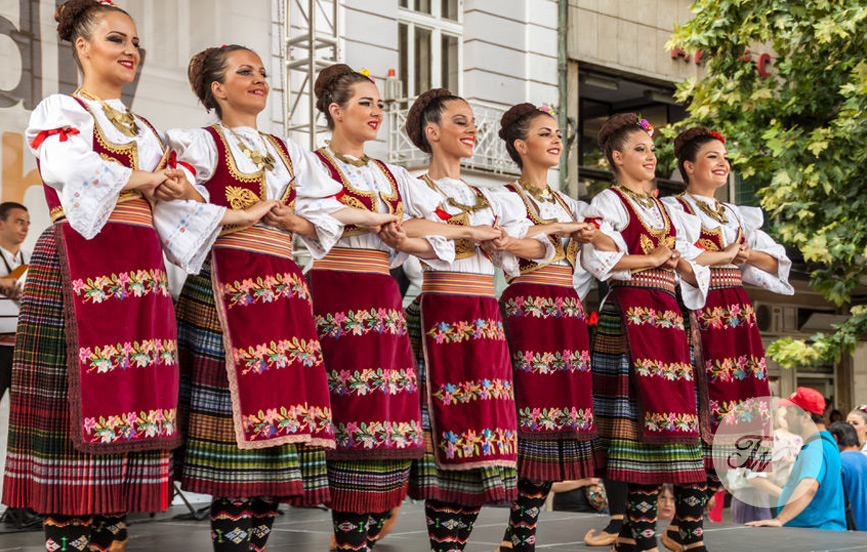Much of the music
from Serbia is similar to that of the larger Balkan region. A large portion of
traditional early music is tied to the church, especially music from the
Medieval Period. During this time, court music pretty much made up the rest of
their music. Later, more secular music used epic poetry as its basis.
The gusle (a
1-stringed fiddle) was often used in the music using that epic poetry. (Skip forward on the video below to about the 1:30 mark to watch an example of the gusle.) Other
instruments you can hear include the gadje (bagpipes), several kinds of lutes
(tambura, tamburitza, gusle, kaval, bouzouki), different kinds of drums
(tarambuke, davul), frula (a 6-holed wooden flute), diple (another woodwind
instrument), zurna (another wind
instrument that looks like a small trumpet), the accordion, and the duduk (a
double reed instrument made from apricot wood).
Serbia has a long
history with its folk music. Generally, they’ve divided it into rural and urban
folk music. And unlike many cultures as we enter the modern era of music,
Serbia never dissed theirs: they incorporated it into other musical styles.
Today, there are a plethora of musicians who integrate traditional folk styles
into pop, jazz, and a combo of different genres. During the 1970s and 1980s,
many of the lyrics spanned between typical folk poetry themes to more of an
edgier political nature (anti-Communism). After the break-up of Yugoslavia and through
the 1990s and 2000s, turbo-folk emerged, which brought rock and electronic
dance music into the folk genre. And the lyrics got racier as well! Think sex,
drugs, and rock-n-roll!
Although many folk
songs were danced to, there is one type of folk dance that stands out: the
kolo. It's a circle dance, most often danced to the music of an accordion. And
it’s almost done entirely with feet and no movement from the waist up (perhaps a
little like Irish dancing in that aspect).
One of the faults
of teaching Western classical music is that it generally only covers certain
music of certain countries: England, Germany, Austria, Italy, France, Russia,
the United States with a few others added in for effect. However, there are
whole cultures of classical composers not extensively studied. Serbia has
produced many classical musicians and composers alike, many who have studied
under some of the top European legends. If you’re looking for something
different to perform, try looking up some of these names: Stevan Stojanovic
Mokranjac, Petar Konjovic, Stevan Hristic, Miloje Milojevic, Ljubica Maric, and
Milan Ristic.
I found quite a few
musicians on Spotify. The first ones I listened to were several artists who
sung various folk traditions. In some songs, I could definitely tell a modernization
to them. For one, they used modern instruments, but with trills and
vocalizations that were indicative of folk styles. Some of these musicians
include Silvana Armenulic, Lepa Lukic, Vesna Zmijanac, Neda Ukraden, and Lepa
Brena.
They also have some
dance/EDM/pop representation with MC Stojan. Still including plenty of Serbian
flare, he mixes these styles with others like hip-hop and incorporates
traditional instruments in with the electronic sounds.
Mile Kitic brings a
little more of a pop sound to his music that also clearly incorporates Serbian
vocal folk styles. However, compared to the earlier folk music where I felt
like I was at an international festival, this one made me think I could
probably hear this on the radio. Sanja Dordevic, Tina Ivanovic, and Indira
Radic are other singers who also make me think I’d hear their music a little
more commercially.
I even found a few
rock musicians here as well! Smak is a blues rock band that I very much enjoyed
listening to. Van Gogh is another band I listened to (I wonder if they
pronounce it as “van goff” like the rest of everywhere-that’s-not-the-US?). The
lead singer has a deep voice that sounds like the Serbian answer to that
Canadian band from the 1990s, Crash Test Dummy.
As far as Serbian
hip-hop goes, I found a few who hold up. I was hoping I would. It was kind of
an interesting listen; you can tell they pulled their influences from a variety
of places. Beogradski Sindikat uses a lot of strings in their music, which I
like. I also listened to two female rappers: Sajsi MC (with DJ Bko) and Mimi
Mercedez. Sajsi MC’s music tended to be a little more on the EDM side of
things, while Mimi Mercedez had more of a “hardcore” sound to it (not to
mention that every song had “explicit” next to it, even though I had no idea
what she was rapping about). I’m just happy they have some female rappers.
Up next: the food

No comments:
Post a Comment